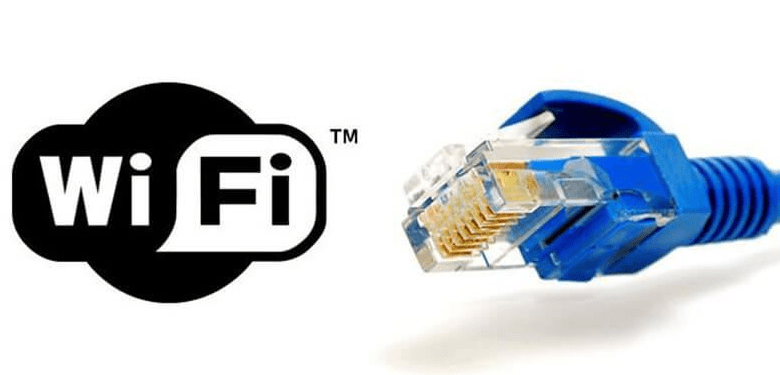Why Ethernet Slower Than Wifi? Best Information In 2024

Welcome to the age of lightning-fast internet connections ethernet slower than wifi. Where we can stream movies, video chat with loved ones across the globe. And download files in a matter of seconds. But have you ever wondered why your Ethernet connection seems to be slower than your WiFi? It’s a puzzling phenomenon that many of us have experienced, leaving us scratching our heads in frustration. Well, fear not! In this blog post, we’ll delve into the world of Ethernet and WiFi to uncover the reasons behind their speed differences. So grab a cup of coffee and get ready to unravel the mysteries behind this perplexing technology!
The Basics Of Ethernet And WiFi
Ethernet and WiFi are two of the most common types of networking technologies used to connect devices to the internet. Let’s start with Ethernet. It is a wired connection that uses cables to transmit data between devices. Typically, an Ethernet cable will have RJ-45 connectors on both ends, which plug into the Ethernet ports on your computer or router.
On the other hand, WiFi, also known as wireless fidelity, allows devices to connect to the internet without any physical cables. Instead, it uses radio waves to transmit data through wireless routers and access points. One key difference between Ethernet and WiFi is their speed capabilities. Generally speaking, Ethernet offers faster speeds compared to WiFi connections. This is because wired connections provide a more stable and reliable connection since they are not susceptible to interference from other electronic devices or physical obstacles like walls.
WiFi connections, while convenient for their mobility and ease of use, can be affected by various factors such as distance from the router, signal interference from other electronic devices (microwaves anyone?), or even thick walls that block signals.
It’s important to note that both Ethernet and WiFi have evolved over time with new standards being introduced regularly. For example, Gigabit Ethernet offers speeds up to 1000 Mbps (megabits per second), while WiFi 6 can reach speeds of up to 9.6 Gbps (gigabits per second).
The basics of Ethernet and WiFi helps us grasp why one might be ethernet slower Than wifi the other in certain situations. But fear not! There are ways we can improve our Ethernet connection speed – stay tuned for some tips coming right up! And remember folks: whether you’re team wired or team wireless, both technologies play crucial roles in keeping us connected in this digital age!
The Speed Differences Between Ethernet And WiFi
When it comes to comparing the speed of Ethernet and WiFi, there are some notable differences. Ethernet, being a wired connection, typically offers faster and more reliable speeds compared to WiFi. This is because Ethernet uses physical cables to establish a direct connection between devices and the network, while WiFi relies on wireless signals that can be affected by various factors.
Ethernet connections can provide speeds up to 1 Gbps or even higher in some cases. This makes it ideal for tasks that require large amounts of data transfer such as online gaming or streaming high-definition videos. On the other hand, WiFi speeds usually range from 100 Mbps to 500 Mbps depending on the router and signal strength.
One reason why Ethernet tends to be faster is due to its dedicated bandwidth. With a direct wired connection, you don’t have to worry about sharing your internet speed with other devices like you do with WiFi. In busy networks where multiple devices are connected via WiFi, this can result in ethernet slower than wifi overall speeds.
Another factor that affects the speed difference between Ethernet and WiFi is interference. Since wireless signals can be disrupted by walls, distance, or other electronic devices operating on similar frequencies (such as microwaves), WiFi connections may experience drops in speed or stability.
Additionally, network congestion can also impact both Ethernet and WiFi speeds. If too many devices are connected at once or if there’s heavy internet traffic in your area, it could lead to ethernet slower than wifi performance regardless of whether you’re using a wired or wireless connection.
While Ethernet generally offers faster and more consistent speeds than Wi-Fi due to its direct wired connection and lack of interference issues commonly found in wireless networks; however! It’s important (!)to consider your specific needs when choosing between these two options – especially if mobility is crucial for your usage scenario!
Factors That Can Affect The Speed Of Ethernet And WiFi
When it comes to the speed of your internet connection, both Ethernet and WiFi can be affected by various factors. Understanding these factors is crucial in optimizing your network performance. One key factor that can impact the speed of both Ethernet and WiFi is distance. The farther you are from your router or switch, the weaker the signal will be, leading to ethernet slower than wifi speeds. This is particularly true for WiFi, as its range is typically limited compared to Ethernet.
Another factor to consider is interference. WiFi signals can be easily disrupted by other electronic devices such as microwaves, cordless phones, or even neighboring networks operating on similar frequencies. On the other hand, Ethernet connections are less susceptible to interference since they use physical cables.
The quality and condition of your networking equipment also play a role in determining speed. Outdated routers or switches may not support faster connection speeds or utilize advanced technologies like Gigabit Ethernet. Similarly, damaged cables or loose connections can result in reduced performance.
Network congestion is yet another factor that affects both Ethernet and WiFi speeds. If there are multiple users simultaneously accessing large amounts of data on a shared network, it can lead to decreased bandwidth availability for each user.
It’s essential to consider bandwidth limitations imposed by your internet service provider (ISP). Even if you have a lightning-fast internal network setup with Gigabit Ethernet capabilities, if your ISP only offers lower-speed plans, you won’t experience maximum speeds regardless of whether you’re using wireless or wired connectivity.
In conclusion , several factors influence the speed of both Ethernet and Wi-Fi connections . These include distance from routers/switches ,interference ,equipment quality ,network congestion,and ISP-imposed limitations. Ensuring optimal performance requires considering these factors when setting up and troubleshooting your home or office network.
Advantages And Disadvantages Of Ethernet And WiFi
When it comes to choosing between Ethernet and WiFi, there are several factors to consider. Ethernet, also known as wired internet, offers a reliable connection with high speeds. It is ideal for activities that require large amounts of data transfer, such as online gaming or streaming 4K videos. With an Ethernet connection, you can enjoy uninterrupted browsing without worrying about signal interference or congestion. It allows you to connect multiple devices without the need for cables. This flexibility is particularly useful in homes or offices where mobility is important. You can move freely around your space while staying connected to the internet.
However, WiFi signals can be affected by various factors such as distance from the router, walls or obstacles in between, and interference from other electronic devices. This can result in ethernet slower than wifi speeds compared to Ethernet connections.
Another disadvantage of WiFi is its vulnerability to security risks. Wireless networks are more susceptible to hacking attempts than wired connections. To mitigate this risk, it is essential to set strong passwords and use encryption protocols like WPA2.
Both Ethernet and WiFi have their own advantages and disadvantages. The choice depends on your specific needs – if speed and reliability are crucial for your tasks, then go for Ethernet; if mobility and convenience matter more than absolute speed, then opt for WiFi!
Tips For Improving Ethernet Speed
1. Check your cables: The quality of your Ethernet cables can have a significant impact on the speed and stability of your connection. Make sure you are using Cat6 or Cat7 cables, as these provide higher speeds compared to older cable types.
2. Update your network drivers: Outdated network drivers can cause slow Ethernet speeds. To ensure optimal performance, regularly check for updates and install them if available.
3. Minimize signal interference: Keep your Ethernet cables away from sources of electromagnetic interference, such as power cords or appliances. This will help prevent signal degradation and improve overall speed.
4. Optimize router placement: Ensure that your router is placed in a central location with minimal obstructions, such as walls or furniture, between it and the devices connected via Ethernet. This helps to maximize signal strength and minimize potential speed drops.
5. Upgrade your equipment: If you’re still using an older router or switch, consider upgrading to newer models that support higher data transfer rates. This can significantly improve the overall speed of your Ethernet connection.
6. Disable unnecessary applications: Certain applications running in the background may consume bandwidth unnecessarily, leading to ethernet slower than wifi speeds for other tasks using Ethernet connections. Close any unused programs or limit their network usage to free up bandwidth for essential activities.
By implementing these tips, you can optimize your Ethernet connection’s performance and enjoy faster speeds for all your online activities!
Future Predictions For Ethernet And WiFi Technology
As technology continues to advance at a rapid pace, it is only natural to wonder what the future holds for Ethernet and WiFi. Here are some exciting predictions that experts have made regarding these two communication technologies.
1. Faster Speeds: One of the most anticipated advancements in both Ethernet and WiFi is faster speeds. With the increasing demand for high-bandwidth applications such as streaming 4K videos, virtual reality gaming, and smart home devices, there is a need for networks that can handle higher data rates. In response to this demand, researchers are continuously working on developing new techniques and protocols that will enable even faster transfer speeds.
2. Enhanced Security: As our lives become increasingly connected through IoT devices, security becomes paramount. In the coming years, we can expect significant improvements in network security measures for both Ethernet and WiFi connections. This includes stronger encryption algorithms, more robust authentication methods, and advanced intrusion detection systems to protect against cyber threats.
3. Seamless Integration: Another prediction is seamless integration between Ethernet and WiFi networks. Currently, switching between wired (Ethernet) and wireless (WiFi) connections can be cumbersome or require additional hardware setups. However, future advancements may allow for automatic handoff between these two technologies without any interruptions or delays.
4. Introduction of Li-Fi: While WiFi has revolutionized wireless connectivity using radio waves, another technology called Li-Fi may soon take center stage. Li-Fi uses visible light communication (VLC) instead of radio waves to transmit data wirelessly at extremely high speeds while also providing increased security compared to traditional WiFi signals.
5. Improved Power Efficiency: Energy efficiency is crucial in today’s world where sustainability plays a vital role in technological development.
Tomorrow’s Ethernet and Wi-Fi technologies are expected to be more power-efficient than ever before by utilizing innovative energy-saving techniques like Power over Ethernet (PoE) standards or Dynamic Frequency Scaling(DFS).
Conclusion
In today’s fast-paced world, connectivity is key. Whether it’s for work or leisure, having a reliable and speedy internet connection has become a necessity. Ethernet and WiFi are two popular options for connecting to the internet, but there can be differences in their speeds.
While WiFi may seem faster at times due to its convenience and widespread availability, Ethernet actually has the potential to provide a more stable and faster connection. However, several factors can affect the speed of both Ethernet and WiFi connections.
Factors such as distance from the router, network congestion, interference from other devices or materials can all impact the performance of your internet connection. Additionally, outdated hardware or software settings could also be limiting your speed.
When it comes to advantages and disadvantages, Ethernet offers reliability and consistency in terms of speed but requires physical connectivity through cables. On the other hand, WiFi provides convenience with wireless access but may suffer from signal strength issues depending on various factors.
If you’re experiencing slow Ethernet speeds or want to maximize your existing setup’s potential, there are some tips you can try:
1. Ensure that all cables are securely connected.
2. Upgrade to higher-quality cables if necessary.
3. Check for firmware updates on your router.
4. Optimize your network settings for better performance.
5. Limit background activities that consume bandwidth.
Looking ahead into future technology developments in 2024 and beyond. We can expect both Ethernet and WiFi technologies continue to evolve with even faster speeds becoming available. With advancements like Wi-Fi 6E expanding bandwidth capacity and multi-gigabit ethernet offering lightning-fast connections over traditional copper wires.




